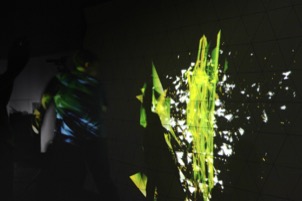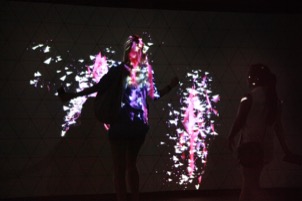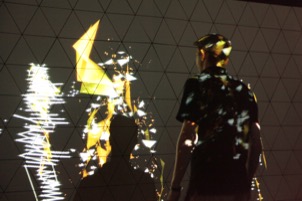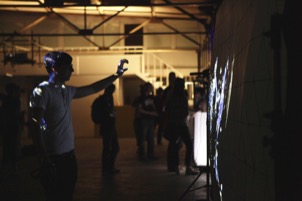Prologue
What power do we have to influence our artistic and digital reflections? In what way can we still control them? When are we going to lose control and will we ever gain it back?
Space and Curiosity
A large room... sombre darkness... strange mechanical sounds lure the visitor to stand before a tiled screen. The visitor moves towards the odd construction and the screen starts to react. As the curious onlooker moves closer, an abstract human image appears on the screen. The sounds start to change, the projections distort and the visitor suddenly realises that they can influence and control the installation. The immediate feedback marks the beginning of the exploration process.
Imitation and Play
Exploration is approached in a playful manner. By moving all parts of the body, the visitor attempts to discover and understand the patterns linked to the system of sensors. There is an overwhelming desire to dominate the form projected. Through playful behaviour, control is gained and the installation rewards the visitor with acoustic and optical responses. New patterns and sounds are being created throughout the discovery process. The visitor is able to create visually smooth and coherent images through their movements. This interactive harmony allows the visitor to believe that they are in control of the installation...
Alienation and Reassurance
However, the closer the visitor gets to the installation the more independent it becomes and the harmonious auditory and visual atmosphere distorts. The visitor is literally being driven away. The figure is losing more and more of its humanoid attributes. The pattern of the visual images deviates from the expected transformation and thus from the immediate influence of the observer. It becomes more difficult to receive a smooth and aesthetically pleasing image of oneself. Towards the end, the visitor loses control... the desire for interaction and control of the response is no longer satisfied. This happens in all three areas of the installation: the screen, the projected image and the sounds all gradually deform and deteriorate.
Only by temporarily walking away from the piece, therefore breaking the image interaction, can the visitor come back and repeat the experience and return to the initial synchronisation and the possibility to regain control over their projected avatar.
Video documentation:
- Jacek Brzozowski
- Jan Baumgart
- Matthias Gerding
- Thomas Kombüchen
- Michael König
- David Murmann
- Matthias Schulz



